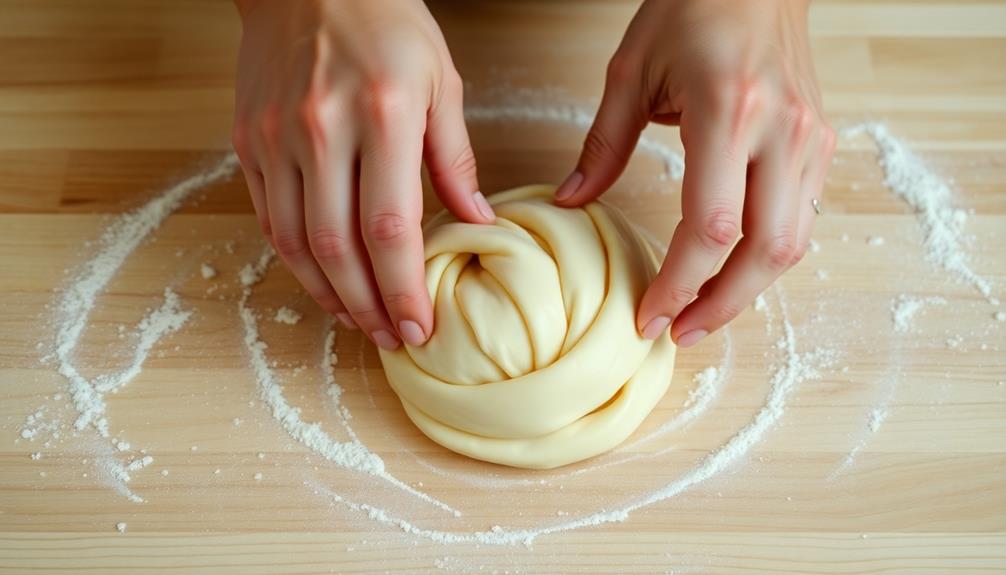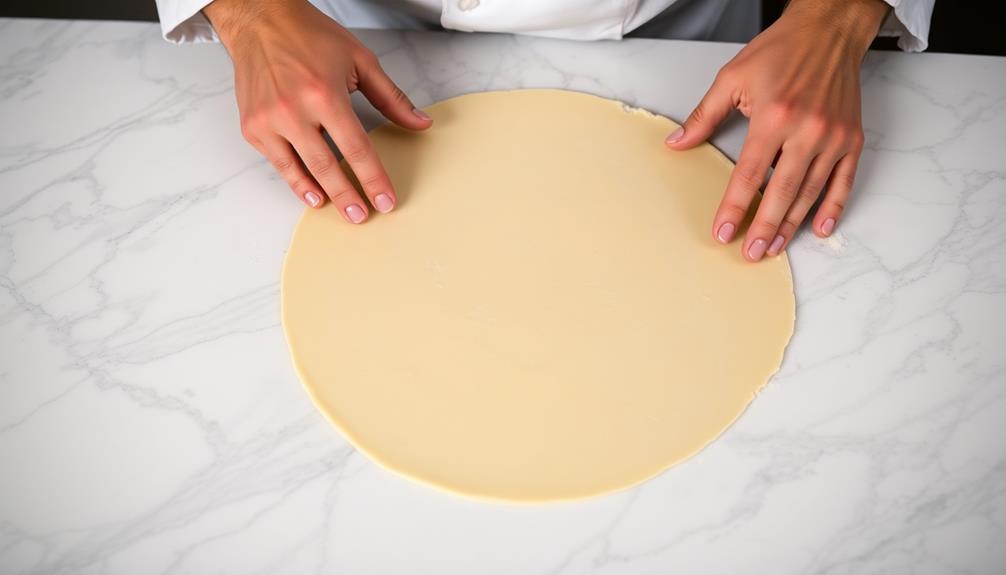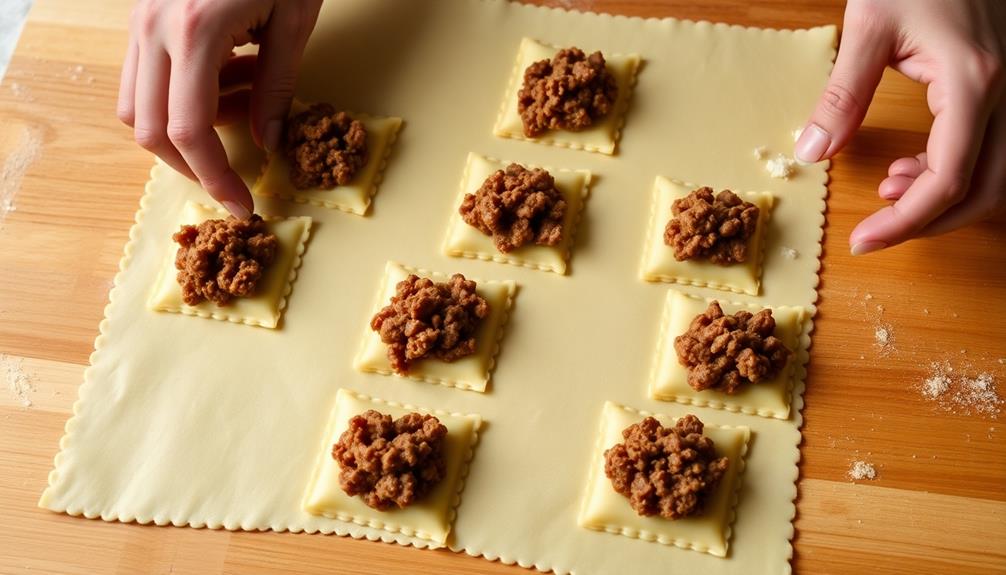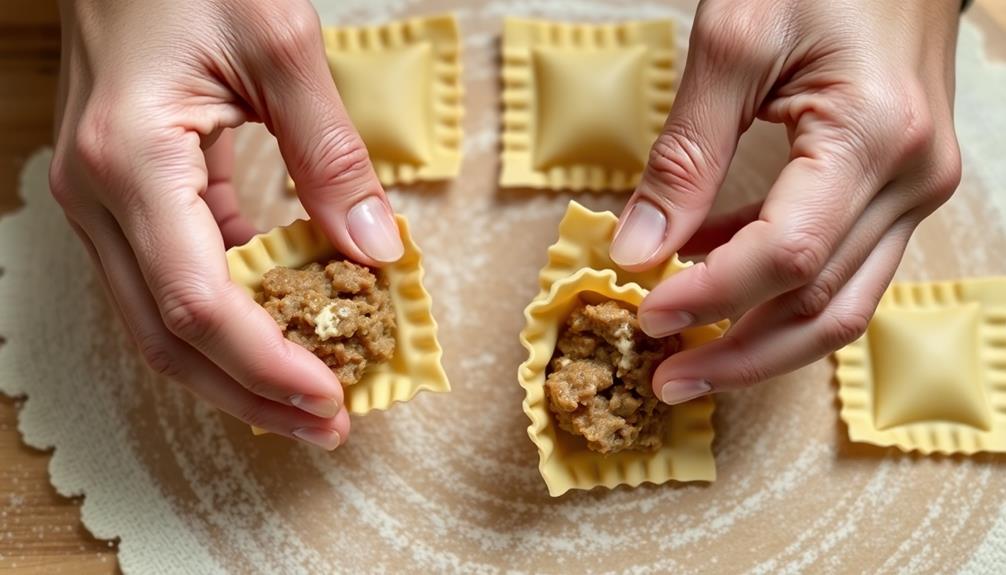Agnolotti is a delightful Italian pasta originating from the Piedmont region, known for its rich, savory fillings and delicate textures. You'll find it stuffed with meats, cheeses, and herbs, and often served in flavorful broths or creamy sauces. The dough is made with a simple blend of flour, eggs, and olive oil, while the fillings can be customized to suit your taste. Sealing the agnolotti properly is key, with a crimping technique that secures the filling. Whether you enjoy it in a classic tomato sauce or experiment with pesto or brown butter, this versatile dish is sure to delight your palate. And there's more to discover about this beloved Italian specialty.
Key Takeaways
- Agnolotti is a small, square-shaped pasta originating from the Piedmont region of Italy, traditionally filled with savory mixtures of meats, cheeses, and herbs.
- The dough is typically made with all-purpose flour, eggs, olive oil, and salt, while the filling can be customized with regional ingredients like Fontina cheese and Barolo wine.
- Cooking techniques involve kneading and rolling the dough, placing the filling, sealing the agnolotti, and boiling or pan-frying them for added texture.
- Agnolotti pairs well with various sauces, such as tomato, pesto, brown butter, and cream-based, which can enhance the flavors of the dish.
- Agnolotti is a versatile dish that can be served in various settings, from casual weeknight dinners to festive occasions, and offers a balance of carbohydrates, protein, and potential health benefits depending on the ingredients used.
History
The origins of agnolotti can be traced back to the Piedmont region of Italy, where this beloved pasta dish has been a culinary tradition for centuries. Passed down through generations, the recipe for these delightful little parcels of dough has evolved, reflecting the creativity and culinary prowess of the local cooks.
In the early days, agnolotti were often made with leftover scraps of pasta dough, which were expertly folded and filled with a savory mixture of meats, cheeses, and herbs. As the dish gained popularity, the filling became more refined, incorporating regional ingredients like Fontina cheese, Barolo wine, and even wild game.
Today, agnolotti are celebrated throughout Italy and beyond, with each family and restaurant putting their unique spin on the classic recipe. Whether served in a simple broth or tossed with a rich, creamy sauce, these delicate pasta pillows continue to delight the senses and bring people together around the table.
Recipe
Agnolotti is a type of small, square-shaped pasta typically filled with a savory mixture of meat, cheese, or vegetables. Originating from the Piedmont region of Italy, this delicate pasta is known for its intricate folding and delightful texture.
The process of making agnolotti from scratch is a labor of love, but the end result is well worth the effort. The combination of the tender pasta and the flavorful filling creates a truly satisfying and authentic Italian dish.
Ingredients:
- 2 cups all-purpose flour
- 3 eggs
- 1 tablespoon olive oil
- 1 teaspoon salt
- For the filling:
- 1 pound ground beef or pork
- 1 onion, finely chopped
- 2 cloves garlic, minced
- 1/2 cup grated Parmesan cheese
- 1 egg
- 1 teaspoon dried herbs (such as thyme, oregano, or basil)
- Salt and pepper to taste
Instructions:
In a large bowl, combine the flour, eggs, olive oil, and salt. Knead the dough until it becomes smooth and elastic. Cover and let the dough rest for at least 30 minutes.
In the meantime, prepare the filling by browning the ground meat in a skillet over medium heat. Add the onion and garlic, and cook until the onion is translucent. Remove from heat, let cool slightly, and then mix in the Parmesan cheese, egg, and dried herbs. Season with salt and pepper.
Roll out the dough into thin sheets and place small spoonfuls of the filling onto the dough, spacing them evenly. Fold the dough over the filling and press to seal, cutting into square shapes.
Bring a large pot of salted water to a boil and gently drop the agnolotti in, cooking for 3-5 minutes until they float to the surface.
When cooking agnolotti, it's important to handle the delicate pasta with care to maintain its shape and integrity. Serve the cooked agnolotti with your favorite sauce, such as a simple butter and sage sauce or a hearty tomato-based ragù. Enjoy this classic Italian pasta dish!
Cooking Steps
Knead the dough until it's smooth and elastic – you don't want any lumps!
Next, roll out the dough into thin sheets so you can easily fill them with the tasty agnolotti mixture.
When you've filled them all, crimp and seal the edges to keep the flavors locked inside.
Step 1. Knead the Dough Thoroughly

Thoroughly kneading the dough is a crucial step in creating delectable agnolotti. Get ready to put on your chef's hat and roll up your sleeves! Knead the dough with vigor, using the palms of your hands to push and fold the dough.
Keep at it for about 5 minutes, until the dough becomes smooth and elastic. Don't be afraid to use a little extra flour if the dough feels too sticky. The key is to work the dough until it's silky-soft and springy to the touch. Imagine you're giving the dough a big hug – that's the kind of tender, loving care it needs.
Once the dough is perfectly kneaded, cover it and let it rest for 30 minutes. This allows the gluten to relax, making the dough easier to roll out later. Patience pays off, so resist the temptation to skip this step.
With your dough ready, you're one step closer to making mouthwatering agnolotti!
Step 2. Roll Out the Dough

With the dough rested and ready, it's time to roll it out. Grab your rolling pin and get ready for some fun! Lightly flour your work surface, then place the dough on top.
Begin rolling, starting from the center and working your way outward. Apply gentle pressure, rolling back and forth to create a thin, even sheet.
As you roll, be sure to rotate the dough occasionally to maintain a consistent thickness. Aim for a delicate, translucent dough that's about 1/8 inch thick. Don't be afraid to dust with more flour if the dough starts sticking.
Once you've achieved the desired thickness, let the dough rest for a few minutes before cutting it into shapes. This helps the gluten relax, making it easier to work with.
Now you're ready to start cutting and shaping your agnolotti. Get ready for some delicious homemade pasta!
Step 3. Fill the Agnolotti

To fill the agnolotti, place the rolled-out dough on a clean work surface. Scoop up a small spoonful of the delicious filling and place it in the center of one half of the dough.
Fold the other half of the dough over the filling to create a half-moon shape. Gently press around the edges to seal the agnolotti.
Use a fork to crimp and decorate the edges, giving the agnolotti a beautiful, signature look. Don't be afraid to get creative! You can experiment with different shapes and designs. Just focus on making sure the edges are tightly sealed.
Once filled, the agnolotti are ready to be cooked in boiling water or broth. Cook them until they float to the surface, about 2-3 minutes.
Serve the tender, pillowy agnolotti with your favorite sauce or simply drizzled with melted butter. Enjoy this delightful homemade pasta! For a fresh and light option, toss the agnolotti in a simple olive oil and herb dressing. If you’re feeling adventurous, try experimenting with a new sauce or seasoning to complement the tender, pillowy agnolotti. You can also pair the pasta with a side of fresh greens or a colorful antipasto platter for a complete meal. For a truly authentic Italian experience, serve the agnolotti alongside a traditional fritto misto recipe packed with fried seafood and vegetables.
Step 4. Crimp and Seal Agnolotti Edges

After placing the filling on the dough, gently fold the dough over to create the half-moon shape.
Now, it's time to crimp and seal the edges of your agnolotti. Use your fingers to firmly press the dough together, sealing in all that delicious filling.
Next, take a fork and gently crimp the edges, creating those signature indents. This not only looks great, but it also helps lock in the filling.
Be sure to press firmly, but not too hard – you don't want to tear the dough.
Step 5. Boil Agnolotti Until They Float

Bring a large pot of salted water to a boil.
Once the water is bubbling away, it's time to add your freshly made agnolotti! Gently lower the pasta into the hot water, being careful not to overcrowd the pot.
As the agnolotti cook, they'll slowly float to the surface, letting you know they're ready.
Keep a close eye on the pot, as it won't take long for the tender pasta to float up. Around 3-5 minutes, your agnolotti should be perfectly cooked through.
Use a slotted spoon to scoop them out, letting any excess water drip off.
Now you can serve your delicious agnolotti however you like – tossed with your favorite sauce, sprinkled with cheese, or simply enjoyed on their own.
The floating agnolotti are a sign that the pasta is light, fluffy, and bursting with flavor, ready to delight your taste buds.
Bon appétit!
Final Thoughts
Agnolotti are a delightful pasta that deserve a spot in your culinary repertoire. These plump, crescent-shaped pockets are bursting with flavor and texture, making them a true delight to savor.
Once you've boiled them until they float, you'll be amazed at how the tender dough and savory filling come together in perfect harmony.
Don't be intimidated by the thought of making agnolotti from scratch. With a little practice, you'll be rolling, stuffing, and crimping these delectable dumplings like a pro.
Serve them with a simple tomato sauce, or get creative with pesto, brown butter, or any other sauce that complements the filling.
Agnolotti are truly a special dish that will impress your family and friends. So why not add them to your next pasta night or holiday feast? You'll be glad you did!
Frequently Asked Questions
How Do You Pronounce "Agnolotti" Correctly?
You pronounce "agnolotti" as ah-nyuh-LOT-tee. The "gn" sound is similar to the "ny" in "canyon," and the emphasis is on the second syllable. Mastering the correct pronunciation will help you sound more authentic when ordering this tasty Italian pasta.
Is Agnolotti the Same as Ravioli?
Agnolotti and ravioli are similar but not the same. Agnolotti is a type of stuffed pasta, typically square-shaped, while ravioli is a bit different, often more circular in shape. Though they share similarities, they're distinct pasta varieties.
What Is the Best Filling for Agnolotti?
When it comes to fillings, you'll find that the best options are typically rich, creamy, and flavorful. Consider fillings like ricotta and spinach, mushroom and truffle, or even a hearty meat-based mixture. The key is to experiment and find what suits your taste buds best.
Can Agnolotti Be Frozen for Later Use?
Yes, you can definitely freeze agnolotti for later use. The pasta will retain its texture and flavor, allowing you to enjoy a fresh, homemade dish even on busy weeknights. Just be sure to properly package and freeze the agnolotti for optimal results.
How Long Will Cooked Agnolotti Last in the Fridge?
Cooked agnolotti will generally last 3-5 days in the refrigerator when stored properly. Make sure to keep it in an airtight container and consume it within that time frame for the best quality and safety.










